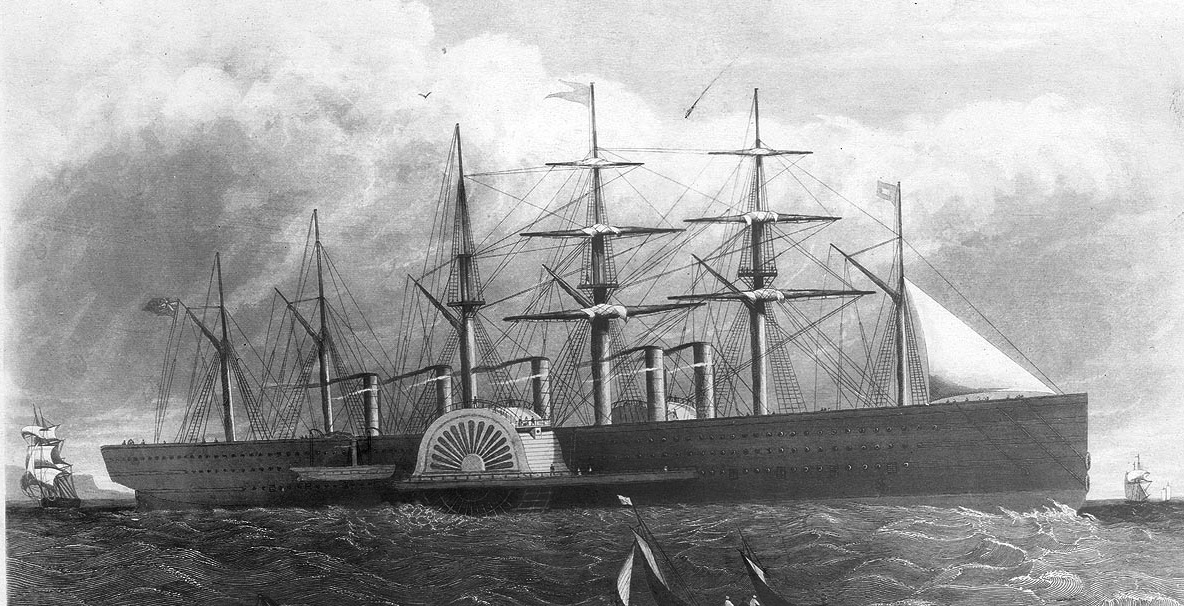Optimum size & population (incomplete)
OPTIMUM SIZE & POPULATION

Brunel’s “SS Great Eastern” (1859)
IMPOSSIBLE ENGINEERING
Discovery Channel has featured at least 2 “Extreme Engineering” documentaries proposed for Japan. The “Shimizu Mega-City Pyramid” for 750,000 people and “Sky City 1000” to be 1000m tall and 400m base width. Such gargantuan structures – with volumes easily 100x that of any existing building – would be an absurdly large technical leap which, in the unlikely event they would ever be attempted, would certainly be crushed by technical and financial problems. The advocates of such ludicrous schemes would do well to recall the experience of the great Victorian civil engineer I.K. Brunel who, in the 1850’s, built the “Great Eastern”, a ship 5 times larger than anything then built – and which was not exceeded in size for almost 40 years. The technical problems and cost overruns on this ‘bridge too far’ project both bankrupted and killed Brunel. His great 6-masted, 5-funneled leviathan, proved to be a white elephant and, after 20 years of heavy losses, followed its maker to its own early death.
WOULD OASIS-CITIES BE IN THE SAME “BRIDGE TOO FAR” LEAGUE..?
Although very large in comparison to all but a few existing buildings, Oasis Cities would be nowhere near the scale of the “Extreme Engineering” hyper-structures.
OPTIMUM SIZE
When considering what might be the optimum size for a 3D City the main considerations would be…
-
- Financial viability
- Technical feasibility
- Urban sociology in high-density environments
- The economics of service provision
- Land availability
FINANCIAL VIABILITY
Based on information from www.dlsqs.com (a Singapore-based consortium which tenders on big international projects) I have estimated a 9 hectare arcology with 5000 apartments could be built in Singapore for approx $US 1.5 billion. In arriving at that figure I generally applied the higher end of their construction costs in each category (eg, residential, commercial, etc) and, considering the uniqueness of a pyramidal building, added an additional 25% ‘technical contingency fund’. However, I believe the project will make a huge impression and be so popular with the visiting public, it could hardly fail being a big financial success. (see below)
Although Singapore building costs are significantly less than those in Europe, Australia, and N.America, by Asian standards (with the notable exception of Japan) they are high. In KL or Bangkok, for example, this project would cost about 40% less. Overall Singapore is about midway on the international scale.
Although the intention would be to lease them, if we assume the 5000 apartments (av 100 m2) were sold for $US300,000 each, this values the residential portion alone at $US 1.5 billion. Considering the residential sector will represent only about 50% of the arcology and given the enormous, entry-fee paying, visitor potential – the commercial sector would be even more valuable. So one can easily appreciate the financial viability of this project even with the apartments valued at what is probably a modest price in booming Singapore.
Advantages of Leasing compared with buying
-
- Discourages financial speculation
- City trust/co-operative have control over admissions
- Absentee investors and holiday flat owners discouraged
- Potential renovations, redevelopment, etc, not frustrated by obstructionist owner-occupier
- Maintain affordability
TECHNICAL FEASIBILITY
Because my proposal is for modest-sized arcologies with ‘footprints’ of probably only 5 or 6 hectares initially, and a maximum of maybe 9, I don’t believe size to be the huge technological barrier that it might appear at first glance. For sake of comparison, the Pentagon – admittedly only 5 storeys high – has an 11 hectare footprint. Although Deltapolis will be only the worlds 2nd live-in pyramid, the architects/engineers of Las Vegas’ 30-storey Luxor Hotel (1993) must have encountered and solved many of the technical problems associated with pyramid-construction, especially one with apartments built into exterior-facing walls, as opposed to the similar-sized Memphis pyramid’s thin veneer walls.
It simply doesn’t make good technical, financial, and sociological sense to build massive million-man arcologies.
The very lengthy construction time – probably 20 years at least – would render them uneconomical
Enormous size would also defeat one of the prime objectives of arcology – that cities should be ‘walkable’.
Enormous arcologies (eg, 1000m base length) would require an internal pod-style rapid-transit system. But, aside from being very expensive to construct, such systems would clutter the interior with their guideways (tracks) and access points. In modestly-sized walkable OA-Cities they would be un-necessary, except possibly as links to adjacent modules.
URBAN SOCIOLOGY
Congestion
in a 100 hectare mega-arcology the ideal of having convenient walking access to the Domain will be compromised.
A 500m walk to the Domain may not be too far for those who live on or close to the ground floor but, if one lives halfway up (say 300m) or more, it would certainly make one think twice about a casual stroll outside. Of those who do make the effort most will gather close to the exits and are unlikely to stray too far away. Those who do will appreciate the greater tranquility on the perimeter and will view the distance as a plus. However, it is fair to say that the circulation of people will tend to be much more congested than if the same population were spread amongst several smaller arcologies.
Financial and technical considerations notwithstanding,
although a single Soleri-sized mega-structure of 240,000 may theoretically provide more open space per capita than 20 small arcologies of 12,000 – in the latter example the open space will be much more easily accessible and more evenly distributed.
ObeCities create and encourage segregation, and I don’t mean of the racial type –
What is the point of living amongst 10 million people in a vast sprawling obecity where ‘east is east and west is west and never the twain shall meet’? At work in the city center you probably mix with people from outlying suburbs – you make friends with some of them and what happens? – aside from occasionally gatherings in the pub after work you rarely if ever bother to meet each other socially mainly because the distances are too great.
SERVICE PROVISION ECONOMICS
‘Critical Mass’
The original and ultimate intention is that each arcology unit should be a fully self-contained community with its own schools, hospital, library, shops, hotels, restaurants, work-places, etc., and should contain a cross-section of society not just the moneyed ‘leisure class’ such as are attracted to a luxury vessel like “The World”.
However, I am not so idealistic as to believe the ideal will be realized from the outset, or even for some time thereafter. Early versions of the motor car and aeroplane were the playthings of a moneyed elite. Thus, unless government subsidized, early arcologies are likely to be subjected to normal supply and demand economics which means they will be ‘exclusive’ (an adjective meaning ‘to exclude those who haven’t got the wherewithal’)
Thus the degree of service provision will depend on the inhabitant profile.
However, assuming that the ideal of a mini-city is realized, what should be the optimal population?
I’m not aware of any studies done on this topic, but my gut feeling would be that a ‘critical population mass’ is one where it becomes economical for a community to support fairly substantial public facilities, entertainment outlets, shops, and private business and employment opportunities, etc. I would estimate this number to be at least 5000, but possibly more like 10,000.
However, arcologies will be so revolutionary, and beautiful to behold, that millions of people will want to come and see them and they will be prepared to pay for the privilege. For some years, until they become commonplace, they will become powerful magnets for hotel-staying tourists and day visitors alike.
LAND AVAILABILITY
High land costs and lack of sufficiently large vacant sites mean that few arcologies will be built in central areas of cities, except where there are old industrial ‘brownfield’ sites. The site of London’s Millennium Dome, located on the tip of a 500m wide neck of land where the Thames bends sharply, would have been a fabulous site for an arcology and an infinitely better and more recognizable icon than that tacky and useless ‘circus tent’ of a white elephant.
COMPACTNESS
The m-ch, now in use and available throughout Europe, combines techniques for high-quality compact “living” spaces deployed in aircraft, yachts, cars and micro apartments. Its design has been informed by the classic scale and order of a Japanese tea house, combined with advanced concepts and technologies. Living in an m-ch means focusing on essentials — less is more. The use of progressive materials complements the sleek design. Quality of design, touch and use were the key objectives for the micro-compact home team, for “short-stay smart living.”

Leave a Reply